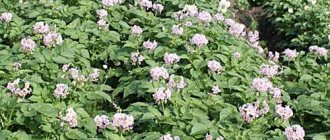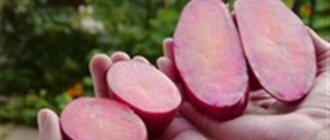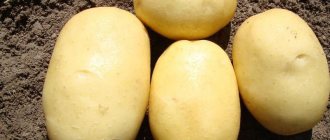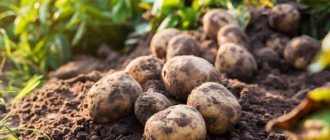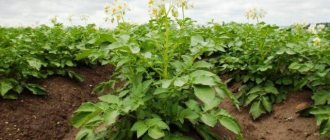Description and characteristics
Description of Colette's appearance
Potato tops are low. The leaves are medium-sized, with a wavy edge. The corolla of the flower is medium in size, reddish-lilac in color. Tubers are oblong in shape. The peel is thin, smooth to the touch, lemon-colored. The flesh is the same shade. The vegetable is distinguished by a low starch content, 12-15%. Therefore, potatoes do not darken when peeled and boiled. Does not lose shape during heat treatment. The weight of one potato is no more than 120 g, the eyes are small.
Landing dates
The planting time of this variety depends on the region of cultivation. In the southern regions, potatoes are planted in late April - early May. In the north and center of the country in mid or late May.
There are 3 conditions for starting agricultural work:
- Sufficient soil moisture.
- Its warming up.
- There is no threat of frost.
Potato ripening time
Colette is an early variety in terms of ripening time. Maturity occurs within 50-65 days after planting. Young potatoes begin to be eaten in mid-June. Technical maturity occurs 65-80 days after germination, after which the potatoes can be stored.
Potato harvest per hundred square meters
The yield of any crop depends on the area of cultivation. Fertile soils, good care and maturity of the tubers will increase the yield. After 1.5 months you can collect 110-130 kg per hundred square meters. When harvesting mature potatoes, the yield increases by 2 times. From one bush you can collect 10-12 tubers, weighing from 60 g to 125 g.
Taste qualities
In the rating of taste quality, the variety occupies the top line. Many dishes are prepared from Colette potatoes. When cooked, the pulp does not darken or become soft. Therefore, the variety is used to make chips and French fries, which always have a presentable appearance.
Colette potatoes are suitable for chips or French fries
Colette growing regions
Colette is actively cultivated in our country and neighboring countries. On fertile soils in the Central region and in the south of the country, you can harvest 2 crops per season. The variety is recommended for cultivation in the Middle Zone, Volga-Vyatka and North Caucasus regions. Cool and wet weather is not an obstacle to a good harvest.
Disease resistance
Colette potatoes have poor immunity to late blight. The variety is resistant to golden potato nematode and cancer. They note high resistance to blackleg, viruses A and Y. You can understand why potatoes are sick by reading the article about the signs of potato diseases.
Keeping quality of the Colette variety
You can preserve the harvest for a year, subject to storage conditions. The cellar or basement must have ventilation, the air temperature should not exceed +3◦. The quality preservation indicators of the variety are not lower than 92%, although these are early potatoes. To preserve the harvest until the end of spring, follow the recommendations from the article about harvesting and storing potatoes.
Possible diseases and how to deal with them
Colette potatoes are highly resistant to diseases and pests, but if care rules are not followed, this can lead to a number of negative consequences. Due to increased humidity, potatoes can develop late blight - a dangerous fungal disease that can lead to the death of potatoes. When the first signs are detected, the plants should be treated with fungicides. Pests such as wireworms, Colorado potato beetles, and potato moths are also dangerous for potatoes. Which have a very detrimental effect on the growth of the crop, and as a result on its productivity. If pests are detected, the plants must be treated as soon as possible with special chemicals.
Remember that it is better to prevent disease and treat seed material with specialized preparations before planting than to fight diseases and pests - which does not always end well.
How to increase potato yield
There are several known ways to increase potato yield:
- balanced plant nutrition;
- timely landing;
- use of sprouted tubers;
- planting at optimal soil temperatures;
- Irrigation of plants, timely weeding;
- use of plant protection products;
- appropriate crop rotation.
How to properly care
Fertilizer is very important for plants
This potato variety is favorable for cultivation due to its yield and commercial characteristics. But it is worth knowing that this species loves a lot of attention, especially when it comes to soil and moisture during flowering. Abundant watering must be carried out both on hot days and on ordinary days.
In addition, the ground must be dug up to a depth of 2-3 cm. Loosening is carried out very carefully, as there is a possibility of damage and breaking off the potato stems. Until the first shoots appear, check the area every day and remove weeds. During care, you need to focus your attention on processing. This procedure provides a good opportunity to increase the number and volume of fruits. Treatment of the plant is very important after the first shoots, as it protects the first shoots from high and low temperatures.
The main role in the development and growth of fruits is played by fertilizing, which must be carried out throughout the entire growing season.
- The first feeding with a specially prepared solution is used if weakness is observed in the potato bush. It is not difficult to notice, as the stems begin to become thinner and the tops acquire a pale tint. To prepare the solution, take 10 liters of water and mix it with 1 tsp. urea and 1 tbsp. l. special fertilizer - "Effecton".
- In the middle of growth, fertilize with wood ash and potassium sulfate.
- The last feeding is carried out during the flowering period. For this purpose, Effekton fertilizers and superphosphate are used.
If the first symptoms of potato infection with various diseases or parasites were noticeable, then hilling of the plant is carried out with special means that show a fairly strong effect. “Albit”, “Poliram”, “Ordan”, “Kurzat” or “Hom” are suitable for this. Also, a product such as “Kuproksat” gives an excellent effect. It is used during the growing season at a working fluid consumption of 400 l/ha.
You can harvest potatoes in any convenient way, either manually or using special equipment. If the garden area is large enough, then technology will help facilitate and speed up the process itself. When the stems begin to dry, this is a signal that it is time to harvest the potatoes. It is advisable to start digging in clear, not rainy weather. Such conditions will help to allow the potatoes to dry before storing them. Vegetables can be stored for a long time; they do not spoil quickly.
Reviews about the variety
Alina, Podolsk
I’ve only planted a few rows of Colette, this is my second year, and I’ll say right away that the taste is not impressive. I like my boiled potatoes to be crumbly. I pour oil on top and sprinkle with herbs. This variety holds its shape, but tastes like soap. I grow it only for frying, but when fried it’s delicious, it’s not for nothing that it’s called a potato for chips.
Victor, Klin
I like Colette because it ripens quickly. 1.5 months after planting, almost all summer, we eat young potatoes. I can’t say that it is more productive than other varieties. Our plot is well fertilized, so we don’t have to take special care of it. In recent years, summers have not been very warm, but the variety consistently produces crops.
Features of growing Colette
Everyone knows that Colleta is a potato variety that can be grown twice per season. Moreover, its yield will be high if properly prepared for planting. The vegetable is planted in the ground, depending on the region. In the south it is typical to start planting at the end of April, but in the north of the country the season begins in the middle and lasts until the end of May.
To get a good harvest, you need to analyze soil moisture and temperature
The absence of frosts is also important, since they greatly affect potato yields.
Preparing for landing
To get a high yield, instructions for proper planting and care must be followed. It is recommended to germinate Colleta potatoes before planting them in the ground. Thus, the time for the development of the bush in open ground will be reduced.
Germination is done as follows:
- seed potatoes are carefully sorted, only healthy tubers are selected;
- for germination, it is best to use boxes where the seed tubers are placed and sprinkled with humus;
- potatoes are laid in layers, between which compost or humus is poured and Gumi is watered;
- the top layer is also covered with compost;
- then the boxes are wrapped in film and placed in a dark, warm place for germination.
Sprouted potatoes are planted in the ground
Advice. When planting potatoes in the ground, it is better to place them sprouts down. This will result in a large spreading bush that will bring a good harvest.
Landing
Potatoes are planted in holes located at a distance of 25 centimeters, into which ash and humus are placed. The distance between rows should be at least 75 centimeters. During the process of potato growth, it is necessary to do weeding and hilling. When the potatoes are ripe, you need to cut off the tops before digging them up.
Care
Caring for Colette potatoes includes the following steps.
This process must be carried out in order to ensure air flow to the roots of the potato bush and the removal of weeds. The first time the soil is loosened after the first shoots appear. The hoe should not go deeper than one and a half centimeters in depth. During the growth process, loosening can be carried out in parallel with hilling.
Hilling
To get a good harvest, this process must be done several times.
The first hilling should be carried out immediately after germination. In this case, the potatoes can be covered with soil.
This way, the sprouts will not freeze at night, when the air temperature is still significantly lower. Before the first flowering, it is recommended to “burn” the potatoes two more times.
It is done if the summer is hot and it rains very rarely. Soil moisture is very important for potatoes, but you need to have a sense of proportion and not over-wet the soil.
For feeding, mineral fertilizers such as Nitrophoska are used. Fertilizer is applied for the first time when it becomes noticeable that the potato bushes are weak, the stems are thin, and the leaves have lost their color saturation. Subsequent application of fertilizers is carried out every ten days.
The first shoots of Colette potatoes
Landing
Plant potatoes of the Colette variety when the soil has warmed up to + 3◦-+4◦. For better germination, pre-germinate the seeds. Treat the tubers with drugs that stimulate growth and disease resistance. For example: Prestige or Albit. The distance between rows should be 60-70 cm, between holes - 30-40 cm.
It is useful to put a handful of ash in each hole to feed and protect against wireworms. You can learn about the rules for planting potatoes here.
Advantages and Disadvantages of Culture
The Colette variety has a lot of advantages, for which it has received recognition and respect from experienced vegetable growers:
- early and simultaneous ripening of tubers;
- strong immunity and resistance to certain diseases;
- presentation and excellent taste of the product;
- long-term storage;
- the possibility of long-term cultivation in one area while maintaining varietal qualities.
See also
Description and treatment of potato pests, measures to combat them
Read
Disadvantages include:
- high demands on soil;
- tendency to late blight;
- poor yield in dry and cold summers.
Note: Good predecessors for this variety are legumes, annual grasses and winter crops. The best predecessors include mustard. Colette does not need frequent changes of location: it grows well in one area for several years.
Care
Light, fertile soils will provide you with a good harvest. Try to use organic fertilizers annually on the site. It is imperative to weed and water the plants in a timely manner. The crop requires especially a lot of moisture during the period of budding, tuber setting and in a dry year. Hill up, like other varieties, 3 times per season. The first time is when the potatoes have just sprouted, the second time is before flowering, the third time is when you need to sprinkle the tubers with soil. Find out when is the best time to hill potatoes.
During the growing season, feed the crop with Nitrophoska 3 times. Remember that nitrogen ensures plant growth. Feed it in the spring, do not overdo it, excess fertilizer will lead to the growth of tops, not tubers.
Apply phosphate before and after setting tubers. Potassium is absorbed by potatoes throughout the growing season. From organic matter, it is better to use ash at the time of planting and throughout the season. Look what else gardeners feed potatoes with.
Pros and cons of the variety
The Colette potato variety has received well-deserved recognition among gardeners in its short period of existence, thanks to its many advantages. This standard also has disadvantages, but they are significantly fewer compared to the advantages.
pros
- Excellent taste.
- Early ripening of the variety.
- Ability to produce a second harvest per season.
- Long shelf life.
- Attractive appearance of tubers.
- Low starch content.
- Good transportability.
- Resistance to nematode damage.
Minuses
- Sensitivity to late blight infection.
- Reduced productivity in cold climates.
Harvesting
The timing of potato harvesting varies depending on the growing region. After 1.5 months it can be eaten. Remove for storage when the tops are dry. When signs of late blight appear before harvesting, it is better to trim the stems so that the tubers do not get sick.
Harvest potatoes in dry weather, preferably by hand. The potato skin is very thin, try not to damage it. Let it dry well and lie in the sun.
The seeds are greened before being stored in the cellar. Sort the tubers by size, quality and storage. The room temperature should be no higher than +3◦, air humidity 80%. How to properly store potatoes can be found here.
Santa
The variety was bred in Holland. Entered into the State Register in 1993. Recommended for cultivation in the Central, Volga-Vyatka, North-Western, Far Eastern, Western regions.
Description of the variety:
- Mid-early. Readiness for harvesting - 80–95 days from planting.
- The bushes are compact, with a minimal amount of greenery.
- Abundant fruiting. Up to 20 root crops are removed from the bush.
- The mass of the oval tuber is about 150 g. The dimensions and shape are the same.
- The skin is thin, but dense, yellow in color, with small eyes.
- The pulp is yellow.
Potatoes do not boil softly due to the small percentage of starch content.
Advantages of the variety:
- high taste, lack of wateriness and dryness;
- rapid ripening and high yield;
- long shelf life, super resistance to damage;
- transportability;
- drought resistance.
Kamensky and 5 more elite potato varieties that are worth paying attention to
The disadvantages for gardeners include intolerance to temperature fluctuations, which leads to a sharp decrease in yield.
Methods for propagating Colette potatoes
Most summer residents propagate potatoes by planting tubers. Other methods are no less well known. You can grow potatoes by dividing the tubers. To do this, take a large potato, cut off the apical eyes along with the pulp and plant them in sawdust. Cover the tubers without apical eyes with soil, cut side up. The other eyes will now begin to wake up. After a week, divide the tubers into parts according to the number of eyes and plant them in a permanent place.
There is a method of propagation by sprouts that appear on seed potatoes. Carefully break off the sprouts; you can even divide them into several parts. It is important that each has 2 buds. Plant the sprouts in boxes and water them. Plant in a permanent location when the weather is favorable.
It can also be propagated by cuttings. To do this, choose the most powerful bushes and cut off strong branches from them. Remove excess foliage and tops, leaving one leaf with a bud. Disinfect the cuttings with a weak solution of manganese. In a horizontal position, sprinkle it with soil, leaf side up, and water it. In a month, tubers will appear on the cuttings.
The culture is propagated by seeds. To do this, do not dig up several bushes during harvesting. There are seeds in green boxes, let them dry and store them. In February, sow and water the planting material. After 2 weeks, sprouts will appear. 45 days after this, the crop can be planted in the ground.
The most popular methods of growing crops are propagation by eyes and peel. Cut out the sleeping eyes and plant them in a box with soil, water them. When their height has reached 10 cm, the air temperature is + 10°, they can be planted in the garden. Cut the peel thicker, do not disturb the eyes. Do the rest by analogy.
Main diseases and pests
The Colette variety is resistant to many diseases. Shows sensitivity to late blight, resistant to damage by golden nematode.
Late blight
A fungal disease that can cause great damage to the harvest of Colette potatoes is late blight. Occurs due to high humidity in the air and soil. May appear when using contaminated seed material.
Black and brown spots appear on the stems and foliage. Over time, these spots grow, and the leaves turn black, curl and dry out. Then late blight spreads to the tubers. Affected potatoes begin to rot and become unfit for consumption.
In the early stages of the disease, it is still possible to save the harvest of the Colette variety by treating potato bushes with special preparations Efal, Ditan, Revus, Acrobat. Can be used to spray plants with a solution of copper sulfate 0.2%
Wireworm
A pest that gnaws holes in Colette potato tubers and thus causes damage to the crop is the wireworm. It is a worm 2-3 cm long, brown-yellow in color. The wireworm infects the stems of plants, literally making holes through them. Moves to tubers and damages them.
For prevention, it is recommended to dig up the area later with the arrival of the first frost. Pest larvae dug to the surface will not survive the cold and will die. Another method of combating the parasite is the complete removal of creeping wheatgrass and its roots, on which the pest feeds, from the area where the Colette variety grows. Chemical agents are also used to get rid of wireworms. For example, Prestige KS, Taboo Trio.
Medvedka
A pest that causes enormous damage to vegetable crops, including Colette potatoes, is the mole cricket. It is a beetle with claws. The pest moves underground and can sometimes make sounds. The mole cricket chews through young potato stems, destroys tubers, eating away the pulp.
To combat the parasite, you can use the granular drug Medvetox, which has protective characteristics, which should be placed in the area where potatoes grow, dropping the granules into holes in the ground. Some gardeners set up mole cricket traps by burying glass jars in the ground. Pests fall into traps and are unable to get out.

